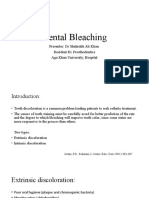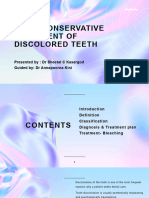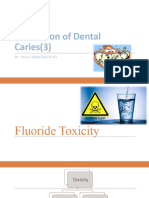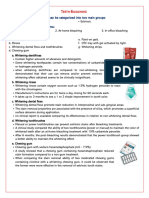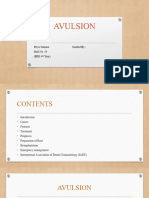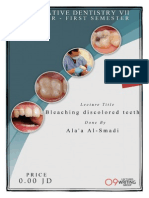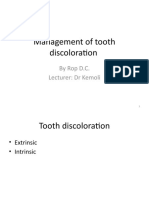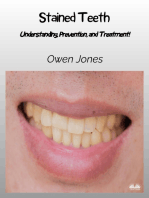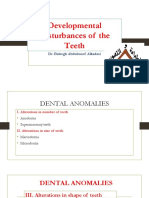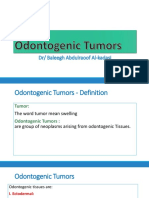Bleaching Final 2019 PDF
Bleaching Final 2019 PDF
Uploaded by
Emad AlriashyCopyright:
Available Formats
Bleaching Final 2019 PDF
Bleaching Final 2019 PDF
Uploaded by
Emad AlriashyOriginal Title
Copyright
Available Formats
Share this document
Did you find this document useful?
Is this content inappropriate?
Copyright:
Available Formats
Bleaching Final 2019 PDF
Bleaching Final 2019 PDF
Uploaded by
Emad AlriashyCopyright:
Available Formats
بسم هللا الرحمن الرحيم
Professor. Abdulwahab I. Al-kholani
Treatment of Discoloured Teeth (Bleaching)
or Tooth whitening
Professor Abdulwahab Al-kholani
Lecture contents
Tooth Bleaching - Terminology
Tooth Bleaching - Techniques
Tooth Stains
Extrinsic Tooth Stains
Intrinsic Tooth Stains
Combination
Treatment of Discolored Teeth
Indications and contra indications of bleaching
Microabrasion Technique
Home, Chemical and power bleaching
Sensitivity
Advantages and disadvantages of Bleaching
Internal bleaching stages
Discoloration after Bleaching
Clinical Recommendations
Overall Conclusions
Professor. Abdulwahab I. Al-kholani
Tooth Bleaching or Tooth whitening
Professor. Abdulwahab I. Al-kholani
Bleaching Techniques
For vital teeth For non vital teeth
Professor. Abdulwahab I. Al-kholani
Tooth Bleaching - Terminology
Internal “Non-vital”
i.e. Root-filled
“Vital”
External i.e. Normal pulp
Professor. Abdulwahab I. Al-kholani
Bleaching Techniques for (vital) Teeth
Home bleaching Chemical in office Power office bleaching
bleaching
Professor. Abdulwahab I. Al-kholani
Bleaching Techniques for (non vital) Teeth
Internal bleaching
Professor. Abdulwahab I. Al-kholani
Street bleaching
Professor. Abdulwahab I. Al-kholani
Street bleaching
Professor. Abdulwahab I. Al-kholani
Tooth Stains
• Extrinsic Intrinsic Extrinsic & Intrinsic
It is essential to determine the cause of
the discolouration prior to treatment
Professor. Abdulwahab I. Al-kholani
Extrinsic Tooth Discolourations
• Cigarettes, pipes, cigars, chewing
tobacco - yellowish-brown to black
• Marijuana - dark brown to black rings
Professor. Abdulwahab I. Al-kholani
Extrinsic Tooth Discolourations
• Cigarettes, pipes, cigars, chewing
tobacco - yellowish-brown to black
• Marijuana - dark brown to black rings
• Coffee, tea, foods - brown to black
• Poor oral hygiene - various colours
Professor. Abdulwahab I. Al-kholani
Extrinsic Tooth Discolourations
• Cigarettes, pipes, cigars, chewing
tobacco - yellowish-brown to black
• Marijuana - dark brown to black rings
• Coffee, tea, foods - brown to black
• Poor oral hygiene - various colours
• Fluorosis - White, yellow, brown,
grey, and/or black
Professor. Abdulwahab I. Al-kholani
Intrinsic Tooth Discolourations
• Genetic conditions
• Amelogenesis imperfecta - brown, black
• Systemic Conditions
• Jaundice - blue-green or brown
Professor. Abdulwahab I. Al-kholani
Intrinsic Tooth Discolourations
• Genetic conditions
• Amelogenesis imperfecta - brown, black
• Systemic Conditions
• Jaundice - blue-green or brown
• Medications during tooth development
• Tetracyclines, fluoride - many colours
Professor. Abdulwahab I. Al-kholani
Intrinsic Tooth Discolourations
• Genetic conditions
• Amelogenesis imperfecta - brown, black
• Systemic Conditions
• Jaundice - blue-green or brown
• Medications during tooth development
• Tetracyclines, fluoride - many colours
• Body by-products
• Bilirubin - blue-green or brown
• Haemoglobin - grey, black
Professor. Abdulwahab I. Al-kholani
Intrinsic Tooth Discolourations
• Pulp changes
Professor. Abdulwahab I. Al-kholani
Intrinsic Tooth Discolourations
• Pulp changes
• Pulp canal obliteration (PCO)
• Increased dentine thickness - yellow
Professor. Abdulwahab I. Al-kholani
Intrinsic Tooth Discolourations
• Pulp changes
• Pulp canal obliteration (PCO)
• Increased dentine thickness - yellow
• Pulp necrosis (PN)
• With haemorrhage - grey, black
• Release of haemoglobin and iron
• e.g. trauma
Professor. Abdulwahab I. Al-kholani
Intrinsic Tooth Discolourations
• Pulp changes
• Pulp canal obliteration (PCO)
• Increased dentine thickness - yellow
• Pulp necrosis (PN)
- With haemorrhage - grey, black
Release of haemoglobin and iron
e.g. trauma
- No haemorrhage - grey-brown
Protein degradation products
Professor. Abdulwahab I. Al-kholani
Intrinsic Tooth Discolourations
• Iatrogenic causes
Professor. Abdulwahab I. Al-kholani
Intrinsic Tooth Discolourations
• Iatrogenic causes
• Trauma during pulp extirpation
• Pulp tissue remnants in pulp chamber
Professor. Abdulwahab I. Al-kholani
Intrinsic Tooth Discolourations
• Iatrogenic causes
• Trauma during pulp extirpation
• Pulp tissue remnants in pulp chamber
• Restorative materials
• Amalgam, composite, gold, pins, etc
• Esp. if marginal breakdown or leakage
Professor. Abdulwahab I. Al-kholani
Intrinsic Tooth Discolourations
• Iatrogenic causes
• Trauma during pulp extirpation
• Pulp tissue remnants in pulp chamber
• Restorative materials
• Amalgam, composite, gold, pins, etc
• Esp. if marginal breakdown or leakage
• Endodontic materials
• Medicaments, sealers, temp. fillings, etc.
Professor. Abdulwahab I. Al-kholani
Intrinsic Tooth Discolourations
• Iatrogenic causes
• Trauma during pulp extirpation
• Pulp tissue remnants in pulp chamber
• Restorative materials
• Amalgam, composite, gold, pins, etc
• Endodontic materials
• Medicaments, sealers, temp. fillings, etc.
Professor. Abdulwahab I. Al-kholani
Intrinsic Tooth Discolourations
• Iatrogenic causes
• Trauma during pulp extirpation
• Pulp tissue remnants in pulp chamber
• Restorative materials
• Amalgam, composite, gold, pins, etc
• Esp. if marginal breakdown or leakage
• Endodontic materials
• Medicaments, sealers, temp. fillings, etc.
All usually brown, grey or black
Professor. Abdulwahab I. Al-kholani
Extrinsic and Intrinsic Discolouration
Professor. Abdulwahab I. Al-kholani
Extrinsic and Intrinsic Discolouration
• Fluorosis
• White, yellow, brown,
grey, and/or black
• Often with mottled enamel
Professor. Abdulwahab I. Al-kholani
Extrinsic and Intrinsic Discolouration
• Fluorosis
• White, yellow, brown,
grey, and/or black
• Often with mottled enamel
• Ageing
• Yellow
• Often with added discolouration
effects of tooth wear, cracks,
restorations, illness, etc
Professor. Abdulwahab I. Al-kholani
Professor. Abdulwahab I. Al-kholani
Treatment of Discolored Teeth
Professor. Abdulwahab I. Al-kholani
Treatment of Discolored Teeth
Determine the cause of the discoloration
Professor. Abdulwahab I. Al-kholani
Treatment of Discolored Teeth
Determine the cause of the discoloration
This will indicate the treatment approach
Professor. Abdulwahab I. Al-kholani
Treatment of Discolored Teeth
• Intrinsic stains • Extrinsic stains
• Internal Bleaching • Change addictive behaviour / habits
- after RCF • Prophylaxis
• Full mouth cleaning and scalling
• Enamel microabrasion
• Bleaching
Professor. Abdulwahab I. Al-kholani
Treatment of Discoloured Teeth
Is their an alternative solution to bleaching and whitening ?
Professor. Abdulwahab I. Al-kholani
Treatment of Discoloured Teeth
• Alternatives to bleaching and whitening
• Labial veneer restorations
Porcelain, composite resin
Professor. Abdulwahab I. Al-kholani
Treatment of Discoloured Teeth
• Alternatives to bleaching and whitening
• Labial veneer restorations
• Porcelain, composite resin
• Crowns
• Porcelain, Zircon, composite resin, acrylic
BEFORE AFTER
Professor. Abdulwahab I. Al-kholani
Professor. Abdulwahab I. Al-kholani
Professor. Abdulwahab I. Al-kholani
Professor. Abdulwahab I. Al-kholani
Professor. Abdulwahab I. Al-kholani
Micro abrasive Technique
Whiteness RM is a stain remover by microabrasion, which has
in its composition hydrochloric acid at 6% and silicon carbide,
that is extremely hard and sharp, which gives it a greater
effectiveness when compared to other abrasives such as
pumice stone, which is softer and not sharp. Thus, Whiteness
RM can be considered a medium-power product with high
effectiveness, because it combines medium acid content with
high effectiveness of silicon carbide.
Kit
1 syringe with 2g
• 10 applicator tips
• 1 spatula
• Instructions for Use
Professor. Abdulwahab I. Al-kholani
Micro abrasive Technique
INDICATIONS
Controlled chemical and mechanical removal of enamel stained by fluorosis,
enamel hypoplasia, structural defects that cause pigmentation, or white stains
from inactive caries.
Professor. Abdulwahab I. Al-kholani
Microabrasion
Professor. Abdulwahab I. Al-kholani
Home Bleaching
Professor. Abdulwahab I. Al-kholani
Professor. Abdulwahab I. Al-kholani
Professor. Abdulwahab I. Al-kholani
Professor. Abdulwahab I. Al-kholani
Professor. Abdulwahab I. Al-kholani
Professor. Abdulwahab I. Al-kholani
Professor. Abdulwahab I. Al-kholani
Professor. Abdulwahab I. Al-kholani
Shammah Or khat
Professor. Abdulwahab I. Al-kholani
Home Bleaching
Professor. Abdulwahab I. Al-kholani
Chemical Bleaching
Professor. Abdulwahab I. Al-kholani
Professor. Abdulwahab I. Al-kholani
Professor. Abdulwahab I. Al-kholani
Sensitivity
Desensitizers
Professor. Abdulwahab I. Al-kholani
Desensitizers
Professor. Abdulwahab I. Al-kholani
Step by step
Step 1
After prophylaxis, apply the desensitizing gel uniformly on the teeth (use a brush or
Cavibrush micro applicator – FGM) and wait for a minimum of 10 minutes.
Step 2
After the application time, remove the gel from the teeth with cotton and plenty of
water. The patient should avoid swallowing the desensitizer.
Notas
1 – Repeat application of the desensitizer as needed or in the case of dental whitening,
accompanying the time of the treatment. The number of application should not exceed
once a day.
2 – In the case of use for prevention of sensitivity during in-office dental whitening, it is
recommended to apply Desensibilize KF 2% before the application of the whitening gel.
Professor. Abdulwahab I. Al-kholani
Advantages of Bleaching
• Quick
• Cheap
• Predictable
• Can be re-done
• Conservative procedure (compared to crowning)
• Original crown form or size retained
• No change to the occlusion
• Restores natural colour and translucence
• No effect on the periodontal tissues (if instruction applied properly)
Professor. Abdulwahab I. Al-kholani
Disadvantages of Bleaching
• Caustic solutions
• Can change the structure of tooth substance
• Not always gives permanent result
• Post operative sensitivity and discoloration in some cases
Professor. Abdulwahab I. Al-kholani
Discoloration after Bleaching
• Possible reasons (Howell 1981)
• Marginal break down of restoration – marginal gaps
• Bacteria and their by-products
• Food, drinks “Leakage”
Professor. Abdulwahab I. Al-kholani
Discoloration after Bleaching
• Possible reasons (Howell 1981)
• Marginal break down of restoration
• Bacteria and their by-products
• Food, drinks
• Permeability of tooth
• Saliva or tissue fluid
• Food, Drinks
Professor. Abdulwahab I. Al-kholani
Bleaching – Stages
Internal bleaching
Professor. Abdulwahab I. Al-kholani
Bleaching - Stages
1. Assess the RCF
Re-do RCF if any doubt - usually!!!
Professor. Abdulwahab I. Al-kholani
Bleaching - Stages
1. Assess the RCF
Re-do RCF if any doubt - usually!!!
Professor. Abdulwahab I. Al-kholani
Bleaching - Stages
• Assess and ? re-do the RCF
• Remove RCF to below C-EJ
Professor. Abdulwahab I. Al-kholani
Bleaching - Stages
• Assess and ? re-do the RCF
• Remove RCF to below C-EJ
• Base over RCF – Barrier
Professor. Abdulwahab I. Al-kholani
Bleaching - Stages
• Assess and ? re-do the RCF
• Remove RCF to below C-EJ
• Base over RCF – Barrier
• Rubber Dam; Access
Professor. Abdulwahab I. Al-kholani
Bleaching - Stages
• Assess and ? re-do the RCF
• Remove RCF to below C-EJ
• Base over RCF – Barrier
• Rubber Dam; Access
• Acid etch, wash & dry
Professor. Abdulwahab I. Al-kholani
Bleaching - Stages
• Assess and ? re-do the RCF
• Remove RCF to below C-EJ
• Base over RCF – Barrier
• Rubber Dam; Access
• Acid etch, wash & dry
• Place thick paste of H2O2/Na Perborate
Professor. Abdulwahab I. Al-kholani
Mix Sodium Perborate with 18% Hydrogen
peroxide on a glass slab.
Professor Abdulwahab Al-kholani
Make sure you mix enough Sodium perborate powder with 18% H2O2 liquid to get a mushy consistency
Professor Abdulwahab Al-kholani
Condense the mixture into the tooth chamber, and allow
~3 mm space from the orafice.
Professor Abdulwahab Al-kholani
Bleaching - Stages
• Assess and ? re-do the RCF
• Remove RCF to below C-EJ
• Base over RCF – Barrier
• Rubber Dam; Access
• Acid etch, wash & dry
• Place thick paste of H2O2/Na Perborate
• Temporary filling
Professor. Abdulwahab I. Al-kholani
Bleaching - Stages
RCF
Barrier
(GIC)
Bleaching
paste
Professor. Abdulwahab I. Al-kholani
Bleaching - Stages
• Assess and ? re-do the RCF
• Remove RCF to below C-EJ
• Base over RCF –Barrier
• Rubber Dam; Access
• Acid etch, wash & dry
• Place thick paste of H2O2/Na Perborate
• Temporary filling - Cavit
• Review after 1 week
• Repeat if necessary
• Restore access cavity
Temporary for minimum 2 weeks
Then do GIC/composite
Professor. Abdulwahab I. Al-kholani
Final Restoration of Access Cavity
• “Sandwich technique”
GIC - dentine replacement
Composite resin - enamel replacement
• Benefits:
• Reduce “microleakage”
• Maintain colour
• “Strengthen” tooth
Professor. Abdulwahab I. Al-kholani
Bleaching - Stages
• Assess and ? re-do the RCF
• Remove RCF to below C-EJ
• Base over RCF - Cavit
• Rubber Dam; Access
• Acid etch, wash & dry
• Place thick paste of H2O2/Na Perborate
• Temporary filling - Cavit
• Review after 1 week
• Repeat if necessary
• Restore access cavity
• Review - 6 mths, 2-3 yrs, etc
Professor. Abdulwahab I. Al-kholani
Before
Final result
Professor. Abdulwahab I. Al-kholani
Before Final result
Professor. Abdulwahab I. Al-kholani
Tooth Bleaching - Terminology
Power office bleaching
Professor. Abdulwahab I. Al-kholani
Power or office
bleaching
Professor. Abdulwahab I. Al-kholani
Clinical Recommendations
• After internal bleaching: • After power bleaching:
• Delay the final restorations for
at least 14 days • Advice patient to stop khat
chewing and smoking and
minimize cola, tea and
coffee intake for 2-3 weeks.
Professor. Abdulwahab I. Al-kholani
Thank you
Professor. Abdulwahab I. Al-kholani
You might also like
- Smear LayerDocument13 pagesSmear LayerDental Spa100% (2)
- B Pharma 1Document30 pagesB Pharma 1Ranjay KumarNo ratings yet
- Bleeching of Discolored TeethDocument130 pagesBleeching of Discolored TeethSanket ShethNo ratings yet
- BleachingDocument15 pagesBleachingفايز العقيلNo ratings yet
- Dental Bleaching: Presenter: DR Shahrukh Ali Khan Resident R1 Prosthodontics Aga Khan University, HospitalDocument47 pagesDental Bleaching: Presenter: DR Shahrukh Ali Khan Resident R1 Prosthodontics Aga Khan University, HospitalShahrukh ali khanNo ratings yet
- Cleaner Whiter Brighter! Handout 2011Document49 pagesCleaner Whiter Brighter! Handout 2011SanaFatimaNo ratings yet
- Management of Discoloured Teeth: Presented By: Amisha Jain M.D.S II YearDocument44 pagesManagement of Discoloured Teeth: Presented By: Amisha Jain M.D.S II YearANUBHA50% (2)
- Droplet DesignDocument72 pagesDroplet DesignArvindNo ratings yet
- BleachingDocument125 pagesBleachingYasmin100% (3)
- Oral Care ProductsDocument34 pagesOral Care ProductsJOSHUA ALCONESNo ratings yet
- Bleaching Extracoronal - ACTDocument21 pagesBleaching Extracoronal - ACTIzanagi NookamiNo ratings yet
- dental-caries-tooth-decay-patient-informationDocument6 pagesdental-caries-tooth-decay-patient-informationRSNo ratings yet
- ALD - Dentalcaries - 18march 2024Document28 pagesALD - Dentalcaries - 18march 2024Lucio CNo ratings yet
- DENTAL CARIES AND ITS CONSEQUENCES DR UrviDocument52 pagesDENTAL CARIES AND ITS CONSEQUENCES DR Urvirahulmimroth04No ratings yet
- Teeth Whitening, Style Italiano ApproachDocument7 pagesTeeth Whitening, Style Italiano ApproachMahmoud HeshamNo ratings yet
- Obturating Materials Used For Pulpectomy in Primary Teeth-A ReviewDocument3 pagesObturating Materials Used For Pulpectomy in Primary Teeth-A ReviewAgnes GamboaNo ratings yet
- Oral Health Promotion and Disease PreventionDocument35 pagesOral Health Promotion and Disease Preventionalijun26091991No ratings yet
- Dental CariesDocument19 pagesDental CariesartswithshikhaNo ratings yet
- Dental ProductsDocument35 pagesDental ProductsMansi JadhavNo ratings yet
- Plaque Control in Children .PptxDocument42 pagesPlaque Control in Children .Pptxfahisraheem009No ratings yet
- Prevention of Dental Caries - 3Document49 pagesPrevention of Dental Caries - 3j6r4qvkrkzNo ratings yet
- Abc of Healthy Teeth: Saveetha Dental College & HospitalsDocument45 pagesAbc of Healthy Teeth: Saveetha Dental College & HospitalsImran RiyazNo ratings yet
- Bleaching - FinalDocument56 pagesBleaching - FinalNimishaNo ratings yet
- Management of Discolored ToothDocument19 pagesManagement of Discolored ToothTsega SK0% (1)
- Regressive Alteration of TeethDocument29 pagesRegressive Alteration of TeethLavanya Kalapala100% (3)
- In Office Teeth Whitening - Case ReportDocument3 pagesIn Office Teeth Whitening - Case ReportDarshilNo ratings yet
- Bleaching 180314114330Document25 pagesBleaching 180314114330Ulfath SultanaNo ratings yet
- Dental ProductsDocument21 pagesDental ProductsRomeo JulietNo ratings yet
- Discolouration of TeethDocument37 pagesDiscolouration of TeethVidhyaNo ratings yet
- Jenny's Smooth Teeth AnswersDocument3 pagesJenny's Smooth Teeth AnswersT LolaNo ratings yet
- Dental Products: Pradeep Bawane Assistant Professor SVKM's IOP, DhuleDocument42 pagesDental Products: Pradeep Bawane Assistant Professor SVKM's IOP, DhulepradeepbawaneNo ratings yet
- Discoloration of Teeth Part 1Document42 pagesDiscoloration of Teeth Part 1Sarah AlviNo ratings yet
- Caries ConsDocument19 pagesCaries ConsChiranthana KanchinalmuttNo ratings yet
- Dental DevelopmentDocument34 pagesDental Developmentronaldfacilitator001No ratings yet
- Teeth BleachingDocument3 pagesTeeth Bleachingnagatemad5No ratings yet
- Powered ToothbrushDocument24 pagesPowered Toothbrushvedeshpatil69No ratings yet
- Oral Hygiene PharmacotherapyDocument3 pagesOral Hygiene PharmacotherapyMichelle Kristine DonnellyNo ratings yet
- Operative DentistryDocument16 pagesOperative Dentistryd.alshameri2022No ratings yet
- Razaw Dental StainDocument20 pagesRazaw Dental StainEhsan AnwarNo ratings yet
- Dental Study Guide Year 3 Plymouth 2010/11 Ms Fenella Fudge 3.6Document4 pagesDental Study Guide Year 3 Plymouth 2010/11 Ms Fenella Fudge 3.6manicmalikNo ratings yet
- Dvlong 160902040733Document23 pagesDvlong 160902040733AnonymousNo ratings yet
- AVULSIONDocument25 pagesAVULSIONbhalaashokkumarNo ratings yet
- BleachingDocument30 pagesBleachingReeshu GargNo ratings yet
- Bleaching of Discolored TeethDocument73 pagesBleaching of Discolored Teethalkaarora677No ratings yet
- Investigatory Project Unique For CBSE Full Marks GuaranteeDocument21 pagesInvestigatory Project Unique For CBSE Full Marks GuaranteetaanusarvNo ratings yet
- DentoalveolarAbscess in Children LectureDocument22 pagesDentoalveolarAbscess in Children LectureARNOLD OBINo ratings yet
- Dental ProductsDocument27 pagesDental Productskamasuke hegdeNo ratings yet
- Abnormalities in The Development of TeethDocument58 pagesAbnormalities in The Development of TeethAME DENTAL COLLEGE RAICHUR, KARNATAKANo ratings yet
- 02 - 01 Internal Bleaching of Teeth An Analysis of 255 TeethDocument8 pages02 - 01 Internal Bleaching of Teeth An Analysis of 255 TeethRenato SouzaNo ratings yet
- 06112023-Fluoride Caries PreventionDocument15 pages06112023-Fluoride Caries PreventionMukmin RadziNo ratings yet
- Remineralization of EclDocument50 pagesRemineralization of EclChaithra ShreeNo ratings yet
- Cons VII Script 1 Bleaching Discolored TeethDocument19 pagesCons VII Script 1 Bleaching Discolored TeethPrince AhmedNo ratings yet
- Dental StainDocument23 pagesDental StainhprpcwxjdmNo ratings yet
- Teeth Whitening LectureDocument67 pagesTeeth Whitening LecturePanagiotisNo ratings yet
- Stain Removing and Whitening by Baking Soda Dentifrice PDFDocument7 pagesStain Removing and Whitening by Baking Soda Dentifrice PDFDoruNo ratings yet
- Tooth Discoloration Part IIDocument35 pagesTooth Discoloration Part IImajed.mostafaNo ratings yet
- Oral Piercing - Art, Fashion or RiskDocument14 pagesOral Piercing - Art, Fashion or RiskVpatelNo ratings yet
- Pharmaceutical Inorganic Chemistry: Unit 3, Chapter 5: Dental Products ScopeDocument1 pagePharmaceutical Inorganic Chemistry: Unit 3, Chapter 5: Dental Products ScopeHanz Zrhyzer CallaNo ratings yet
- Management of Tooth DiscolorationDocument41 pagesManagement of Tooth DiscolorationdianaNo ratings yet
- Discoloration of The Teeth, A Simple Guide To The Condition, Diagnosis, Treatment And Related ConditionsFrom EverandDiscoloration of The Teeth, A Simple Guide To The Condition, Diagnosis, Treatment And Related ConditionsNo ratings yet
- Infectious Control Practices For A Dental Office: Presented By: Hosted byDocument54 pagesInfectious Control Practices For A Dental Office: Presented By: Hosted byEmad AlriashyNo ratings yet
- Orthodontics 1Document8 pagesOrthodontics 1Emad AlriashyNo ratings yet
- Developmental Disturbances of Tooth PDFDocument97 pagesDevelopmental Disturbances of Tooth PDFEmad AlriashyNo ratings yet
- Cardiovascular Diseases: Any Disease That Affects The Heart and The Blood Vessels ExamplesDocument61 pagesCardiovascular Diseases: Any Disease That Affects The Heart and The Blood Vessels ExamplesEmad AlriashyNo ratings yet
- Odontogenic Tumor PDFDocument93 pagesOdontogenic Tumor PDFEmad Alriashy100% (1)
- Evolve Matrix Guide 9-2021-1Document12 pagesEvolve Matrix Guide 9-2021-1Silvio DTNo ratings yet
- Fabricating Complete Dentures With The Copy-DenturDocument5 pagesFabricating Complete Dentures With The Copy-DenturElaine SalvadorNo ratings yet
- Direct Gingivoperiosteoplasty With PalatoplastyDocument6 pagesDirect Gingivoperiosteoplasty With PalatoplastyAndrés Faúndez TeránNo ratings yet
- 3D Printing - An Alternative of Conventional Crown Fabrication A Case ReportDocument7 pages3D Printing - An Alternative of Conventional Crown Fabrication A Case ReportBalavigneshwaran bt18ipf04No ratings yet
- 2D Digital Tracing and SoftwareDocument26 pages2D Digital Tracing and Softwareneven.mortagaNo ratings yet
- English Las PT q4 Week 3Document5 pagesEnglish Las PT q4 Week 3denniskoalaNo ratings yet
- Bai Tap Tieng Anh Lop 8 Unit 9 A First Aid Course Co Dap An So 1Document6 pagesBai Tap Tieng Anh Lop 8 Unit 9 A First Aid Course Co Dap An So 1Lan Anh ShinesNo ratings yet
- Parts of FPDDocument51 pagesParts of FPDDianne Mamaid100% (5)
- Of Dental Sciences: Case ReportDocument4 pagesOf Dental Sciences: Case ReportGede AnjasmaraNo ratings yet
- Palatally Impacted Canines A NewDocument9 pagesPalatally Impacted Canines A Newplayer osamaNo ratings yet
- Tests For Biocompatibility of Dental MaterialsDocument151 pagesTests For Biocompatibility of Dental MaterialsDevanshi SharmaNo ratings yet
- Personal Hygiene & Proper GroomingDocument3 pagesPersonal Hygiene & Proper GroomingMarikar Danica YanezaNo ratings yet
- COMPARISON OF TOOTH ABRASION BETWEEN DATUN AND TOOTHBRUSH 242702020anupriyaDocument78 pagesCOMPARISON OF TOOTH ABRASION BETWEEN DATUN AND TOOTHBRUSH 242702020anupriyanavinlewisNo ratings yet
- 2014 Osce ProtocolDocument15 pages2014 Osce ProtocolAamir BugtiNo ratings yet
- Modern Endodontic Principes IrrigationDocument10 pagesModern Endodontic Principes IrrigationDulgheru StefanNo ratings yet
- Canine Impaction-A Review of The Prevalence, Etiology, Diagnosis and TreatmentDocument26 pagesCanine Impaction-A Review of The Prevalence, Etiology, Diagnosis and TreatmentAnil Marna100% (1)
- EnglishDocument8 pagesEnglishanhadbackup17No ratings yet
- 1 s2.0 S0022391321006958 MainDocument8 pages1 s2.0 S0022391321006958 MainMelissa Lee Gonzalez De La RosaNo ratings yet
- Chronic Pericoronitis Management With Operculectomy Using ScalpelDocument6 pagesChronic Pericoronitis Management With Operculectomy Using Scalpelmonika esterNo ratings yet
- Comparison of The Fracture Resistance of Three Different Recent Composite Systems in Large Class II Mesio-Occlusal Distal Cavities An in Vitro StudyDocument5 pagesComparison of The Fracture Resistance of Three Different Recent Composite Systems in Large Class II Mesio-Occlusal Distal Cavities An in Vitro Studyimran khanNo ratings yet
- LM Chapter 3 Written ReportDocument19 pagesLM Chapter 3 Written ReportJanelle Mae MargalloNo ratings yet
- "No-Touch" Technique For Lip EnhancementDocument11 pages"No-Touch" Technique For Lip EnhancementClaudia Antonia Ortiz Peralta50% (2)
- Subtenly's AnalysisDocument3 pagesSubtenly's AnalysisMariyamNo ratings yet
- Virtual Setup Jaya LakshmiDocument8 pagesVirtual Setup Jaya LakshmiAnu YaraganiNo ratings yet
- Class III and Fixed Functional ApplianceDocument51 pagesClass III and Fixed Functional ApplianceOsama GamilNo ratings yet
- Ectodermal Dysplasia: Feb 2014 Ndbe IiDocument49 pagesEctodermal Dysplasia: Feb 2014 Ndbe IiDENTAL REVIEWER ONLYNo ratings yet
- April 2017-1 MJDFDocument24 pagesApril 2017-1 MJDFsajna1980No ratings yet
- Resume of Neil J. GajjarDocument6 pagesResume of Neil J. GajjarNeil J. GajjarNo ratings yet
- Rate List - IGIMS PDFDocument47 pagesRate List - IGIMS PDFShashank SoniNo ratings yet




